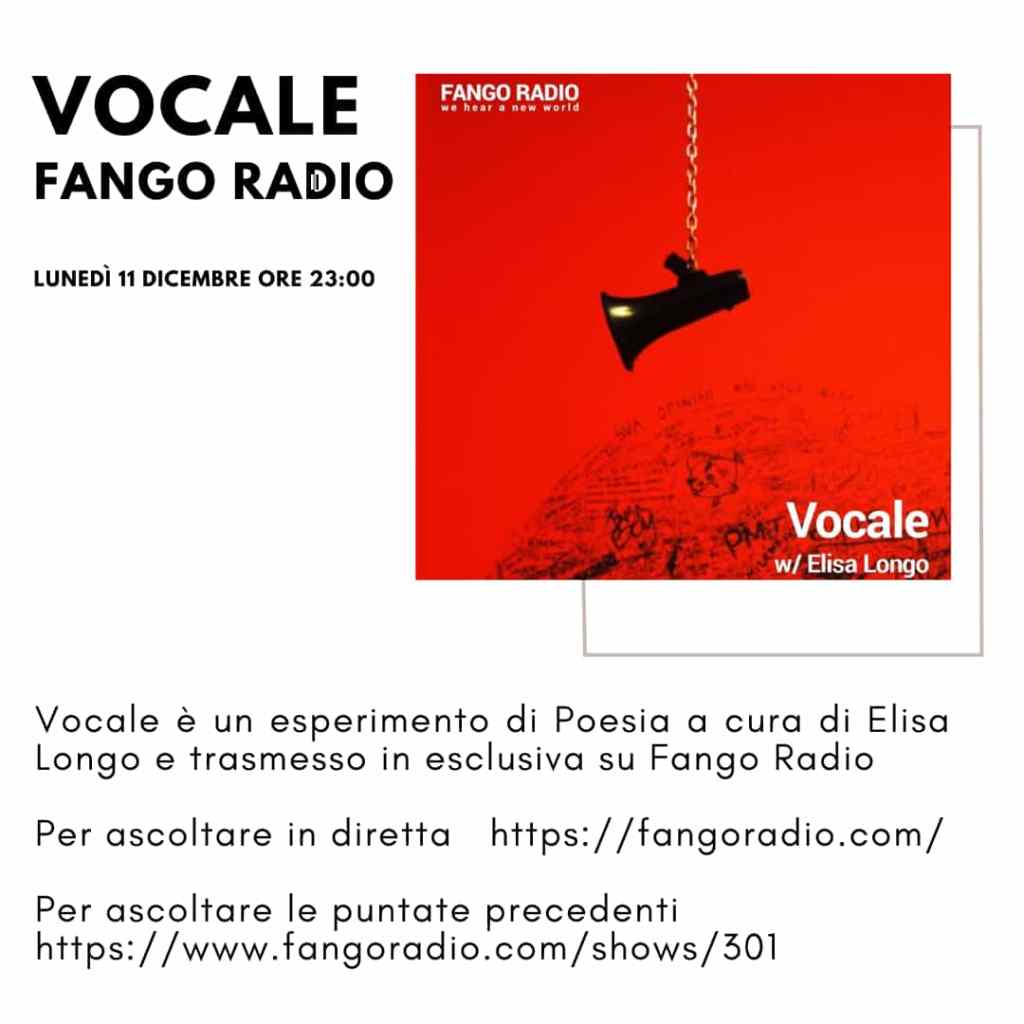Alla Biblioteca Nazionale di Napoli.
Con Maria Iannotti.
Interventi di Carmen Gallo e del traduttore, Domenico Ingenito
_
Archivi tag: Domenico Ingenito
19 dicembre: tutte le poesie di forugh farrokhzad (bompiani), nella traduzione di domenico ingenito, presentazione a napoli
stasera @ fango radio, h. 23: ‘vocale’, a cura di elisa longo

OGGI, lunedì 11 dicembre, alle ore 23:00, nuova puntata di Vocale, un esperimento di poesia trasmesso da Fango Radio.
Questo il link per ascoltare la diretta:
https://www.fangoradio.com/
(Mentre il link per riascoltare le puntate precedenti è https://www.fangoradio.com/shows/301)
Con le voci di
Amelia Rosselli letta da Elisa Longo
Michelangelo Coviello
Antonio Lillo
Rosaria Lo Russo
Mario De Santis
Laura Amponsah
Domenico Ingenito
Tommaso Di Dio
Adriano Cataldo
June Scialpi
Marco Amore
Carmen Gallo
Marcello Strommillo
Elisa Ruotolo
Dome Bulfaro
Stefania Zampiga
Roberta Sirignano
Letizia Polini
Eugenio Griffoni
Antigone
Michela Gorini
Luca Chendi
Marina Corona
Michele Zaffarano
oggi, 6 dicembre, a roma, presso la libreria panisperna: presentazione del volume di tutte le poesie di forugh farrokhzad
roma, 6 dicembre, libreria panisperna: presentazione del volume di tutte le poesie di forugh farrokhzad
domenico ingenito, “gardens of medieval afghanistan”
Persian poetry and the visual arts of medieval Central Asia and Iran cannot be fully appreciated without considering the socio-cultural role of gardens in Persianate societies and the way they informed both the poetic breadth of figurative arts and the visual dimensions of lyric expression.
Early Persian poems of praise were usually introduced by descriptions of natural and amatory vignettes revolving around stylized depictions of princely gardens, palaces, and pavilions. Through such portrayals, poets staged the contrast between the architecturally domesticated space of gardens and the untamed natural settings in which cosmic cycles offered a background for the social festivities presided over by the ruler. Usually discounted as idealized representations that lack historical veracity, such descriptions deserve to be analyzed in the context of the relationship between material culture and the aesthetic impact of poetic creativity.
By focusing on the case of the understudied city of Balkh, the winter capital of the Ghaznavid sultanate, this talk explores the role of gardens in the representation of natural and architectural landscapes in the panegyric poetry of the early Ghaznavids (999-1040 CE). Nestled in a lush oasis that was crossed by a network of rivers and canals, Balkh provided Ghaznavid poets with a complex ecology in which nature and ephemeral architecture overlapped at multiple levels.
The material and symbolic veracity of “architectural” poems and natural descriptions composed by Farrukhi Sistani and ‘Unsuri Balkhi between 1015 and 1035 CE will be compared against evidence provided by geographical and historiographical sources such as Hudud al-‘ālam and Tārikh-i Bayhaqi. These comparisons will help us locate the topographic position of key Ghaznavid gardens in Balkh and explain how ephemeral architectural landmarks emerged through the interaction between urbanized natural contexts and spaces of wilderness.


